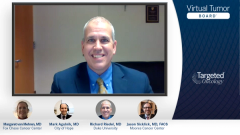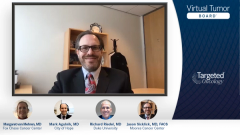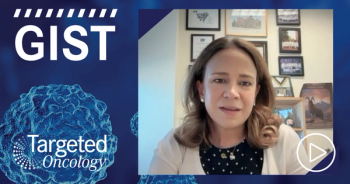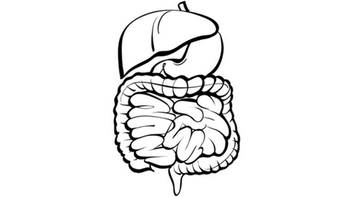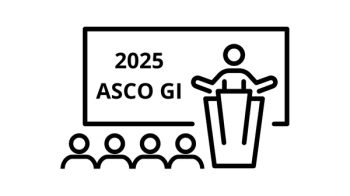
Case 3: The NAVIGATOR Trial
Experts discuss KIT and PDGFRα D842V-mutations in GIST and present the NAVIGATOR trial.
Episodes in this series

Margaret von Mehren, MD: This patient did get NGS [next-generation sequencing] testing, and he has a PDGFRA exon 18 D842V–mutation positive tumor. How often do you see these patients?
Richard Riedel, MD: Probably about 5% or so.
Mark Agulnik, MD: I was going to say very rarely, so that falls into that category as well.
Margaret von Mehren, MD: In general, when we think about GISTs [gastrointestinal stromal tumors], about 85% of them will have KIT mutations. Another 5% or 10% will have PDGFRA. You can see the numbers getting increasingly small. PDGFRA D842V is probably 1 of the more common mutations that we see in that group, but it still represents a small percentage of the tumors that we see. But they’re important to recognize.
The other thing—Rich, you alluded to this—is that most of the time, if you have a KIT mutation, you’re not going to have 1 in PDGFRA, which is why in your pathology department you sequence the mutation. Because most of the time it’s 1 or the other, not both. Are there differences in terms of how these PDGFRA-mutant GISTs present?
Jason Sicklick, MD, FACS: From our experience, they tend to present more distally in the stomach in terms of the location of the tumor. We rarely see in the proximal stomach the cardia and the fundus. In terms of presentation with metastatic disease, it’s uncommon to see metastatic disease with these PDGFRA D842V–mutant GISTs, but it’s certainly within possibility.
Richard Riedel, MD: The patients I’ve seen with D842V had multifocal disease. You think they’re localized. The surgeon will go in, and they’re multifocality. I’m not sure if that’s just an issue with localized tumor rupture. I’m not saying that that may necessarily be unique to the D842V, but how about in terms of aggressiveness? Do you find them to be indolent? Do you find them to act more aggressively in their growth pattern?
Jason Sicklick, MD, FACS: A majority tend to be more indolent, but there’s obviously a subset that may have a high mitotic index and tend to have more aggressive biology. I’ve certainly seen the mix of ones that have metastatic disease at presentation or invading the abdominal wall, adjacent colon, etc.
Margaret von Mehren, MD: They are reported to be more indolent, but they can recur and can metastasize. The challenge in the past has been how you manage these. Because the standard drugs, FDA approved, really didn’t treat these patients. Most of the time there was no disease response and just progression. Many of these patients had more surgery because of lack of other types of therapies.
Mark Agulnik, MD: It also highlights for these, when we’re in tumor boards and we present these cases that have been surgically resected and don’t need anything else and we have the mutation, I like to see these patients to reinforce that they understand that they have to know what their mutation status is, so that they don’t pop up somewhere and get mismanaged at a future date.
Margaret von Mehren, MD: That’s an important point. Depending on your experience level, when you hear GIST, you go to the things that are more common. This is certainly a much less common presentation.
The first exciting thing for these patients was avapritinib. We discussed it earlier in the case that Rich presented. But the study that showed the exciting activity of avapritinib in this disease subset was the NAVIGATOR trial, the phase 1 study.
This study enrolled typical patients who had an ECOG score of 0 to 2, good end-organ function, and a diagnosis of GIST. But in this group of patients, they specifically looked at patients with PDGFRA mutations. These were patients who were considered unresectable and who, particularly if they had a D842V mutation, could enroll in the study without any prior therapy because of the lack of treatments that are effective.
They initially did a dose escalation, as is common in a phase 1 study, to understand what the best dose is. Then they ended up doing an expansion phase where they added additional patients to the D842V cohort to better understand how effective this drug is for those patients.
There were 56 patients with D842V, the largest experience treating these patients ever reported in GIST. Many of these patients had many prior therapies, including some of the patients with D842V who had gone through multiple lines of therapy, trying to find something that was going to control their disease.
The study found that the maximum-tolerated dose was 400 mg but ultimately ended up recommending 300 mg as the dose to be used in the phase 2 setting. When you look at overall response rate in patients with D842V, there was a complete response rate of 9% and a partial response rate of 79%. Unbelievable activity compared with what we’d seen with the rest of the patients and the rest of the drugs we use in this disease.
We can see that the benefit was quite long lasting in terms of progression-free survival at 12 months; 81% of the patients still had their disease controlled. When you looked at overall survival at 1 year, 91% of patients were still alive, with their disease for the most part controlled. These were really exciting data to see.
There are some unique toxicities. We see many of the same things that we see with other TKIs [tyrosine kinase inhibitors]: nausea, diarrhea, fatigue. There can be fluid retention and anemia, which in some patients can be quite severe, grade 3 or 4. Also, fluid retention including things like pleural effusion. Alluded to earlier were some adverse effects of special interest, so cognitive effects. Up to 40% of patients did have some issues and rarely also noted was intracranial bleeding. Seen rarely, both resolved, but treatment was discontinued. That’s something to be aware of in terms of managing these patients.
It is now considered first line for metastatic disease. In the NCCN [National Comprehensive Cancer Network] Guidelines, there is a discussion about its use in the neoadjuvant setting. If a patient has a large D842V mutation tumor, the guidelines say to use it for downsizing, as we’ve discussed.
Mark Agulnik, MD: I’ve treated a few patients with this drug over the last year and a half. My experience has been positive. Certainly, this highlights the need for us to understand the mutations of these tumors and to do a specific therapy for patients. There’s nothing more specific than something like this. With the response rate 80%-plus, about 88% or 87%, this is quite like other drugs. If we think about NTRK fusions and things like that where we are targeting a select number of patients but we are targeting it so effectively, there is nothing more encouraging than this for these patients.
Richard Riedel, MD: I agree. There has been a recent publication looking at the long-term follow-up from NAVIGATOR and showing at least for those who had gotten 300 mg daily, which is the FDA-approved dosage, the response rates were in excess of 90%. Really impressive data.
To Mark’s point, we see a lot of these wonderful waterfall plots with marked activity for molecularly targeted therapies. These data are just as impressive because this—as you alluded to, Meg—was a patient population for whom we had no known effective therapy. Now we have a therapy that benefits most patients. The disease control rate is 100% in the long-term follow-up study.
Transcript edited for clarity.



